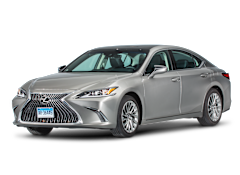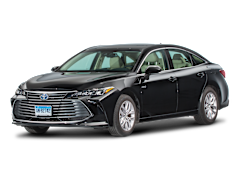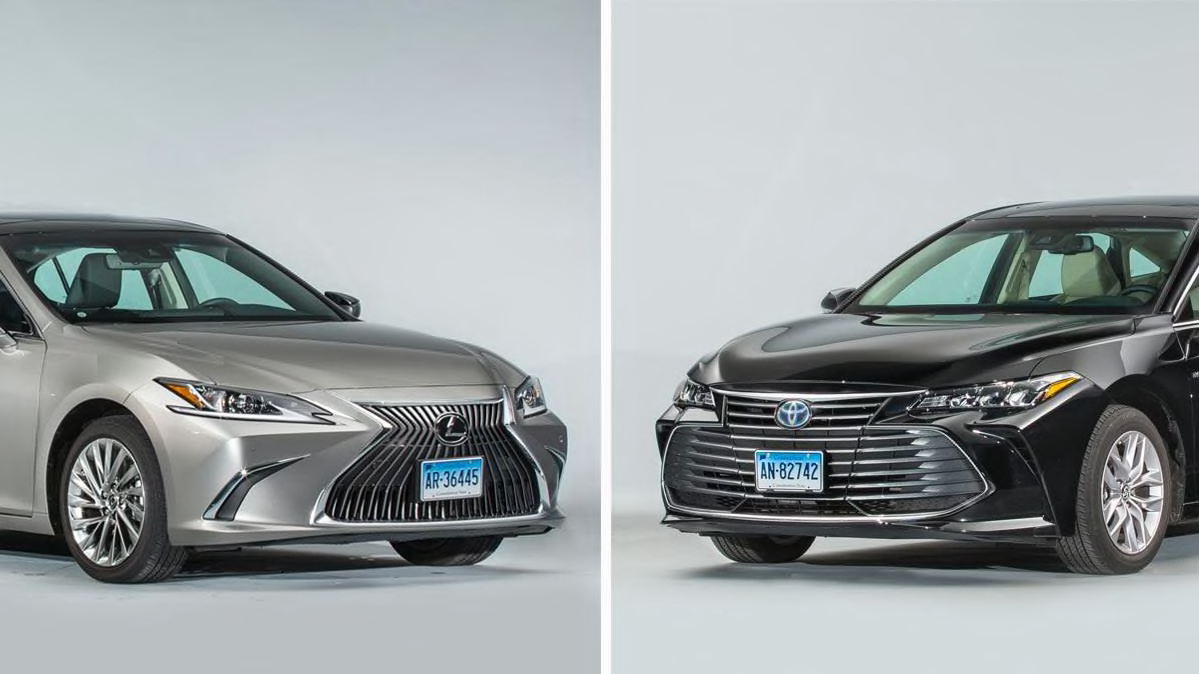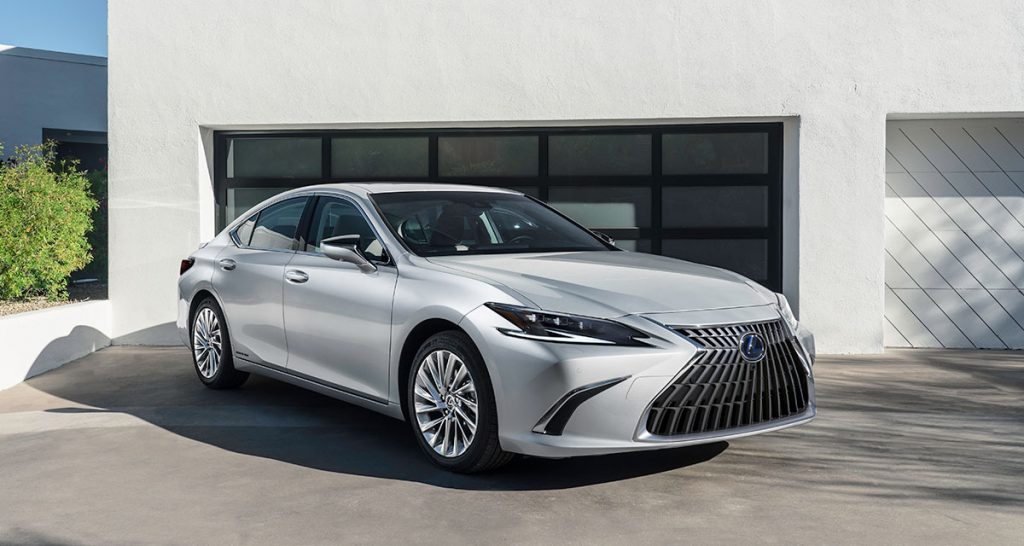From Comsumer Reports.org...........
Face-Off: Lexus ES vs. Toyota Avalon
Despite similarities, the sedans have big differences you should consider
By Jon Linkov
December 26, 2019
19 SHARES
https://www.toyotanation.com/javascript:social_sharing('facebook');
https://www.toyotanation.com/javascript:social_sharing('twitter');
https://www.toyotanation.com/javascript:social_sharing('pinterest');
https://www.toyotanation.com/javascript:void(0);
https://www.toyotanation.com/javascript:window.print();
![The Lexus ES (left) and the Toyota Avalon (right) The Lexus ES (left) and the Toyota Avalon (right)]()
There’s a reason Lexus and Toyota often sit next to each other in Consumer Reports’ reliability rankings: They’re made by the same manufacturer. It’s often the case that a Lexus is a more luxurious version of a Toyota vehicle.
Case in point: the Lexus ES and Toyota Avalon. At their core, these are the same basic car, down to identical lengths, widths, heights, and wheelbases.
Both were redesigned for the 2019 model year, and along with all-new styling inside and out, they use the same new platform found on other Toyota vehicles around the world. The cars offer V6 and hybrid four-cylinder engines, and standard advanced safety and driver assistance systems.
MORE MIDSIZED AND LARGE SEDANS
Genesis G80
Lincoln Continental
Kia Cadenza
Chrysler 300
Chevrolet Impala
But there are key differences consumers should consider. Read below and see how the cars fare in a face-off against each other. At the end, we’ll crown a winner.
If you’re a CR member, this article is already available to you. But if you haven’t signed up, click below and become a member to access this article and all our exclusive ratings and reviews for each vehicle we buy and test. Joining also gives you full access to exclusive ratings for the other products our experts evaluate in several categories, including electronics and appliances.
Sign up for CR’s Cars email newsletter to be notified when we post our latest road tests.
Lexus ES
The Case for It
The ES is among the staff favorites to take on a long trip. While both sedans have stellar ride comfort, the ES stands out because of its supremely quiet cabin. The Avalon is quiet, but the ES does a better job of muting wind, road, and tire noise.
We chose to buy the ES 350 for our test program, which uses a 302-hp, 3.5-liter V6 engine and an eight-speed automatic transmission. It’s the same engine that’s available in the Avalon, and in both cars this combination makes an excellent team. The car accelerates smartly, and there’s plenty of power for passing, no matter the speed.
The transmission shifts quickly and smoothly at both city and highway speeds. Plus, we got 25 mpg overall, which puts it among the top-performing luxury midsized sedans.
Lexus boosted the quality of the ES’ interior with this generation, and it is more impressive than the Avalon’s. There is wood and chrome trim throughout, and plenty of padded surfaces where elbows, forearms, and hands will rest. Most of the interior has a luxe look and feel, and it’s appropriate for a car that costs about $4,000 more than the Avalon.
We like that Lexus uses knobs for radio volume and tuning functions, and hard buttons for the main climate controls. Lexus also made Android Auto compatibility standard for 2020; Apple CarPlay was already supported.
The front seats are firm and supportive, with plenty of adjustments, including four-way lumbar and the ability to extend the length of the bottom cushion to improve leg support.
![Exterior front of the Lexus ES Exterior front of the Lexus ES]()
The Lexus gets the better warranty of the two sedans as well, though that should be expected for a luxury car. The base and powertrain warranties are four years or 50,000 miles and six years or 70,000 miles, respectively. (As with all warranties, it’s whichever limit is reached first.) The Avalon gets only three years or 36,000 miles and five years or 60,000 miles of coverage.
In addition, the rust-through warranty of six years (unlimited miles) and roadside assistance coverage of four years (unlimited miles) for the ES are both better than what the Avalon offers—five years (unlimited miles) and two years (unlimited miles), respectively.
Finally, Lexus includes a number of advanced safety and driver-assistance features standard, including forward collision warning (FCW), automatic emergency braking (AEB), lane departure warning (LDW), and lane keeping assistance (LKA).
![Exterior rear of the Lexus ES Exterior rear of the Lexus ES]()
The Case Against It
There’s one major knock against the ES—the fussy controls for the infotainment system. Lexus equips the ES with a touchpad that’s used to operate the infotainment system, some climate functions, and navigation system. It requires precise movements to land on the selection, and it’s awkwardly located on the passenger side of the center console. It often requires the driver to take his or her eyes off the road for too long to verify that the onscreen cursor is on the desired spot. That problem is compounded by the fact that many functions are buried in multilayer menus.
Each car suffers from the decision to put style ahead of functionality. In the case of the ES, the low roof and very angled windshield pillars make it a challenge for drivers and passengers to gracefully get into and out of the car. Once inside, even average-height seat occupants will find headroom limited, particularly in the rear seat.
In addition, the ES can carry only three large suitcases and one soft-sided bag in its trunk, and the rear seat does not fold to expand the cargo area. The Avalon can carry four bags, and the seatbacks fold to increase cargo room—even in the hybrid.
Lexus equips the ES with standard LEDs for the low- and high-beam headlights. While the low beams are bright and do a good job illuminating the side of the road, they don’t cast enough light down the road to be able to see and react to an object or animal ahead of the car. The high beams do a better job.
Finally, the ES trails the Avalon in terms of standard safety features because both blind spot warning (BSW) and rear cross traffic warning (RCTW) are optional on the Lexus; they’re standard on the Toyota.
![Interior of the Lexus ES Interior of the Lexus ES]()
Shopping for a new sedan?
Check our sedan buying guide and ratings.
Toyota Avalon
The Case for It
If there’s one place where the Avalon stands out from the ES, it’s in terms of controls. The Toyota system is very straightforward, with almost every audio, phone, and navigation setting controlled through the large touch screen, which has physical buttons surrounding it, so the user can jump among the main functions. The audio system has two large knobs for tuning and volume, and the climate system is also managed with large buttons.
Slide into the Avalon’s front seats and you’d be forgiven if you thought the car was a Lexus and not a Toyota. Our XLE’s interior has high-quality leather and wood trim throughout, with stitched and padded surfaces on the door and center armrests. We found the seats comfortable and supportive, with plenty of adjustments to help fine-tune a perfect fit. The Limited trim further narrows the luxury gap between the Avalon and the ES.
The rear seat is particularly roomy, with more space than in the ES. It’s also easier to get into, despite the sloping roofline. The trunk can hold four large suitcases, slightly more than what the ES can carry. And even in the hybrid version, the rear seats can fold down for more cargo room.
![Exterior front of the Toyota Avalon Exterior front of the Toyota Avalon]()
Learn about advanced safety systems.
We chose to test our Avalon with the 2.5-liter four-cylinder hybrid engine and a continuously variable transmission, which is also available in the ES. This powertrain is a truly sensible alternative to the V6. It returned 42 mpg overall in our tests, which is very good for such a large car. It has a cruising range of 545 miles, which is 150 miles more than the V6 version. However, the Avalon hybrid is not much slower than the V6-powered cars in our acceleration tests. There aren’t many compromises to choosing the hybrid over the V6.
The Avalon also gets standard LED low- and high-beam headlights, but they do a slightly better job lighting the road ahead than the ones in the ES.
In addition to the standard FCW, AEB, LDW, and LKA, the Avalon has standard BSW and RCTW; these last two items are optional on the more expensive Lexus.
The Avalon’s warranty isn’t bad; it’s just not as good as the ES’. The base and powertrain warranties are three years or 36,000 miles and five years or 60,000 miles, respectively, while the rust-through warranty and roadside assistance coverage are five years (unlimited miles) and two years (unlimited miles), respectively. That’s all par for the course.
Finally, the hybrid battery warranty is now 10 years or 150,000 miles, up from eight years or 100,000 miles.
![Exterior rear of the Toyota Avalon Exterior rear of the Toyota Avalon]()
The Case Against It
There’s one big compromise to consider when choosing the hybrid powertrain: noise. The engine sound is very coarse when the car is pushed to accelerate, such as merging into traffic or passing at highway speeds. It’s clear that the engine is working hard in those situations. And there’s a mild hum from the four-cylinder engine at lower speeds, which is very noticeable when the car transitions out of all-electric mode.
The car’s swoopy styling has a negative impact on interior comfort. The roofline is low, limiting headroom for tall drivers and passengers. Some drivers found that the center console is wide and cuts into the space where their right knee rests. Unfortunately, the steering wheel doesn’t telescope or extend out particularly far, further compromising the driver’s seating position.
Rear visibility is a challenge because the large back window is heavily sloped, shrinking the viewing area. And the large rear seat head restraints block much of that already compromised area.
The Avalon supports only Apple CarPlay, not Android Auto; Lexus added Android capability to the ES for 2020.
![Interior of the Toyota Avalon Interior of the Toyota Avalon]()
Which One Should You Get?
Bottom Line
Both of these are stellar sedans, and it’s likely no owner would be disappointed with either. Each one has excellent reliability and very high owner satisfaction ratings. And they have similar strengths, including a comfortable ride, composed handling, quiet interiors, and fuel-efficient engines.
We understand that some buyers will be drawn to either model based on the brand, but the Avalon is the rational choice. Its controls are far easier to use, both BSW and RCTW are standard, and the interior is roomier. Add in small details, such as the Avalon’s folding rear seatbacks, and we think there’s really no reason to spend the extra money on a Lexus ES.
QUICK TAKE
87

RECOMMENDED
2020 Lexus ES
Price Range: $39,900 - $45,610
CR MPG: Overall 25 mpg / City 16 / Hwy 38 mpg
#8 of 30: Luxury midsized cars
View Pricing Information
RELIABILITY
OWNER SATISFACTION
All Ratings & Reliability
QUICK TAKE
93

RECOMMENDED
2020 Toyota Avalon
Price Range: $35,875 - $43,300
CR MPG: Overall 42 mpg / City 32 / Hwy 52 mpg
#1 of 17: Large cars
View Pricing Information
RELIABILITY
OWNER SATISFACTION
All Ratings & Reliability
Face-Off: Lexus ES vs. Toyota Avalon
Despite similarities, the sedans have big differences you should consider
By Jon Linkov
December 26, 2019
19 SHARES
https://www.toyotanation.com/javascript:social_sharing('facebook');
https://www.toyotanation.com/javascript:social_sharing('twitter');
https://www.toyotanation.com/javascript:social_sharing('pinterest');
https://www.toyotanation.com/javascript:void(0);
https://www.toyotanation.com/javascript:window.print();

There’s a reason Lexus and Toyota often sit next to each other in Consumer Reports’ reliability rankings: They’re made by the same manufacturer. It’s often the case that a Lexus is a more luxurious version of a Toyota vehicle.
Case in point: the Lexus ES and Toyota Avalon. At their core, these are the same basic car, down to identical lengths, widths, heights, and wheelbases.
Both were redesigned for the 2019 model year, and along with all-new styling inside and out, they use the same new platform found on other Toyota vehicles around the world. The cars offer V6 and hybrid four-cylinder engines, and standard advanced safety and driver assistance systems.
MORE MIDSIZED AND LARGE SEDANS
Genesis G80
Lincoln Continental
Kia Cadenza
Chrysler 300
Chevrolet Impala
But there are key differences consumers should consider. Read below and see how the cars fare in a face-off against each other. At the end, we’ll crown a winner.
If you’re a CR member, this article is already available to you. But if you haven’t signed up, click below and become a member to access this article and all our exclusive ratings and reviews for each vehicle we buy and test. Joining also gives you full access to exclusive ratings for the other products our experts evaluate in several categories, including electronics and appliances.
Sign up for CR’s Cars email newsletter to be notified when we post our latest road tests.
Lexus ES
The Case for It
The ES is among the staff favorites to take on a long trip. While both sedans have stellar ride comfort, the ES stands out because of its supremely quiet cabin. The Avalon is quiet, but the ES does a better job of muting wind, road, and tire noise.
We chose to buy the ES 350 for our test program, which uses a 302-hp, 3.5-liter V6 engine and an eight-speed automatic transmission. It’s the same engine that’s available in the Avalon, and in both cars this combination makes an excellent team. The car accelerates smartly, and there’s plenty of power for passing, no matter the speed.
The transmission shifts quickly and smoothly at both city and highway speeds. Plus, we got 25 mpg overall, which puts it among the top-performing luxury midsized sedans.
Lexus boosted the quality of the ES’ interior with this generation, and it is more impressive than the Avalon’s. There is wood and chrome trim throughout, and plenty of padded surfaces where elbows, forearms, and hands will rest. Most of the interior has a luxe look and feel, and it’s appropriate for a car that costs about $4,000 more than the Avalon.
We like that Lexus uses knobs for radio volume and tuning functions, and hard buttons for the main climate controls. Lexus also made Android Auto compatibility standard for 2020; Apple CarPlay was already supported.
The front seats are firm and supportive, with plenty of adjustments, including four-way lumbar and the ability to extend the length of the bottom cushion to improve leg support.

The Lexus gets the better warranty of the two sedans as well, though that should be expected for a luxury car. The base and powertrain warranties are four years or 50,000 miles and six years or 70,000 miles, respectively. (As with all warranties, it’s whichever limit is reached first.) The Avalon gets only three years or 36,000 miles and five years or 60,000 miles of coverage.
In addition, the rust-through warranty of six years (unlimited miles) and roadside assistance coverage of four years (unlimited miles) for the ES are both better than what the Avalon offers—five years (unlimited miles) and two years (unlimited miles), respectively.
Finally, Lexus includes a number of advanced safety and driver-assistance features standard, including forward collision warning (FCW), automatic emergency braking (AEB), lane departure warning (LDW), and lane keeping assistance (LKA).

The Case Against It
There’s one major knock against the ES—the fussy controls for the infotainment system. Lexus equips the ES with a touchpad that’s used to operate the infotainment system, some climate functions, and navigation system. It requires precise movements to land on the selection, and it’s awkwardly located on the passenger side of the center console. It often requires the driver to take his or her eyes off the road for too long to verify that the onscreen cursor is on the desired spot. That problem is compounded by the fact that many functions are buried in multilayer menus.
Each car suffers from the decision to put style ahead of functionality. In the case of the ES, the low roof and very angled windshield pillars make it a challenge for drivers and passengers to gracefully get into and out of the car. Once inside, even average-height seat occupants will find headroom limited, particularly in the rear seat.
In addition, the ES can carry only three large suitcases and one soft-sided bag in its trunk, and the rear seat does not fold to expand the cargo area. The Avalon can carry four bags, and the seatbacks fold to increase cargo room—even in the hybrid.
Lexus equips the ES with standard LEDs for the low- and high-beam headlights. While the low beams are bright and do a good job illuminating the side of the road, they don’t cast enough light down the road to be able to see and react to an object or animal ahead of the car. The high beams do a better job.
Finally, the ES trails the Avalon in terms of standard safety features because both blind spot warning (BSW) and rear cross traffic warning (RCTW) are optional on the Lexus; they’re standard on the Toyota.

Shopping for a new sedan?
Check our sedan buying guide and ratings.
Toyota Avalon
The Case for It
If there’s one place where the Avalon stands out from the ES, it’s in terms of controls. The Toyota system is very straightforward, with almost every audio, phone, and navigation setting controlled through the large touch screen, which has physical buttons surrounding it, so the user can jump among the main functions. The audio system has two large knobs for tuning and volume, and the climate system is also managed with large buttons.
Slide into the Avalon’s front seats and you’d be forgiven if you thought the car was a Lexus and not a Toyota. Our XLE’s interior has high-quality leather and wood trim throughout, with stitched and padded surfaces on the door and center armrests. We found the seats comfortable and supportive, with plenty of adjustments to help fine-tune a perfect fit. The Limited trim further narrows the luxury gap between the Avalon and the ES.
The rear seat is particularly roomy, with more space than in the ES. It’s also easier to get into, despite the sloping roofline. The trunk can hold four large suitcases, slightly more than what the ES can carry. And even in the hybrid version, the rear seats can fold down for more cargo room.

Learn about advanced safety systems.
We chose to test our Avalon with the 2.5-liter four-cylinder hybrid engine and a continuously variable transmission, which is also available in the ES. This powertrain is a truly sensible alternative to the V6. It returned 42 mpg overall in our tests, which is very good for such a large car. It has a cruising range of 545 miles, which is 150 miles more than the V6 version. However, the Avalon hybrid is not much slower than the V6-powered cars in our acceleration tests. There aren’t many compromises to choosing the hybrid over the V6.
The Avalon also gets standard LED low- and high-beam headlights, but they do a slightly better job lighting the road ahead than the ones in the ES.
In addition to the standard FCW, AEB, LDW, and LKA, the Avalon has standard BSW and RCTW; these last two items are optional on the more expensive Lexus.
The Avalon’s warranty isn’t bad; it’s just not as good as the ES’. The base and powertrain warranties are three years or 36,000 miles and five years or 60,000 miles, respectively, while the rust-through warranty and roadside assistance coverage are five years (unlimited miles) and two years (unlimited miles), respectively. That’s all par for the course.
Finally, the hybrid battery warranty is now 10 years or 150,000 miles, up from eight years or 100,000 miles.

The Case Against It
There’s one big compromise to consider when choosing the hybrid powertrain: noise. The engine sound is very coarse when the car is pushed to accelerate, such as merging into traffic or passing at highway speeds. It’s clear that the engine is working hard in those situations. And there’s a mild hum from the four-cylinder engine at lower speeds, which is very noticeable when the car transitions out of all-electric mode.
The car’s swoopy styling has a negative impact on interior comfort. The roofline is low, limiting headroom for tall drivers and passengers. Some drivers found that the center console is wide and cuts into the space where their right knee rests. Unfortunately, the steering wheel doesn’t telescope or extend out particularly far, further compromising the driver’s seating position.
Rear visibility is a challenge because the large back window is heavily sloped, shrinking the viewing area. And the large rear seat head restraints block much of that already compromised area.
The Avalon supports only Apple CarPlay, not Android Auto; Lexus added Android capability to the ES for 2020.

Which One Should You Get?
Bottom Line
Both of these are stellar sedans, and it’s likely no owner would be disappointed with either. Each one has excellent reliability and very high owner satisfaction ratings. And they have similar strengths, including a comfortable ride, composed handling, quiet interiors, and fuel-efficient engines.
We understand that some buyers will be drawn to either model based on the brand, but the Avalon is the rational choice. Its controls are far easier to use, both BSW and RCTW are standard, and the interior is roomier. Add in small details, such as the Avalon’s folding rear seatbacks, and we think there’s really no reason to spend the extra money on a Lexus ES.
QUICK TAKE
87

RECOMMENDED
2020 Lexus ES
Price Range: $39,900 - $45,610
CR MPG: Overall 25 mpg / City 16 / Hwy 38 mpg
#8 of 30: Luxury midsized cars
View Pricing Information
RELIABILITY
OWNER SATISFACTION
All Ratings & Reliability
QUICK TAKE
93

RECOMMENDED
2020 Toyota Avalon
Price Range: $35,875 - $43,300
CR MPG: Overall 42 mpg / City 32 / Hwy 52 mpg
#1 of 17: Large cars
View Pricing Information
RELIABILITY
OWNER SATISFACTION
All Ratings & Reliability








